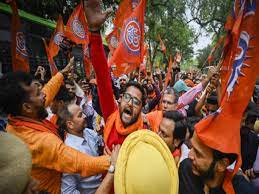Some extracts are worth referring to and taking a closer view on how certain socio-political matters evolve in a democracy.
"The Bajrang Dal was created in 1984 as the Vishva Hindu Parishad’s youth wing in the context of the Ram Janmabhoomi movement," says Christophe Jaffrelot.
What did Bajrang Dal use this strike force against? It targeted artists first. In 1996, Bajrang Dal activists attacked M F Husain’s gallery in Ahmedabad and in 1998 they ransacked his apartment in Bombay in protest against his painting, “Sita Rescued”, which depicted the famous scene in the Ramayana where Sita is freed from Ravana’s clutches — allegedly because she was too scantily clad.
Husain left the country a few years later and died far from his homeland.
 |
| Christophe Jaffrelot |
"In 2000, Deepa Mehta was also a victim of this cultural policing when she made a film on the life of Hindu widows in Varanasi in the 1930s, when these women were condemned to enforced celibacy and begging.
The VHP president immediately declared that the film insulted “ancient Indian culture and traditions”. The set built on the banks of the Ganges was ransacked by the Bajrang Dal and Mehta had to move away from UP."
However, minorities have been the main casualties of vigilante groups, which started to work with the police in BJP-ruled states, including Gujarat in the 2000s and many others subsequently.
This is well illustrated by the division of labour between vigilantes and the police in the context of the cow protection movement, especially in states where the BJP has passed “beef ban” laws.
There, vigilantes patrol the highways and check trucks likely to carry bovines. When the driver happens to be a Muslim, they hand him over to the police — there are also instances of lynching.
The collaboration between the vigilante groups and the police finds expression in a very material way: The former often use the van or the pick-ups of the latter.
More importantly, they work in tandem with specific segments of the police like the Haryana “Cow Protection Task Force”, that was established by the Khattar government in 2021, along with the Gau Seva Aayog, which is in charge of cow protection and dominated by RSS leaders.
In other words, Hindu nationalists stand at the interface of a continuum: At one end, officials, including from the government and police, represent the legal order, whereas at the other end, Hindu vigilantes implement their plans at the grass roots level.
Their activities may be illegal, but they are seen as legitimate as they appear as the footsoldiers of Hinduism, and benefit from highly placed protection and patronage.






No comments:
Post a Comment